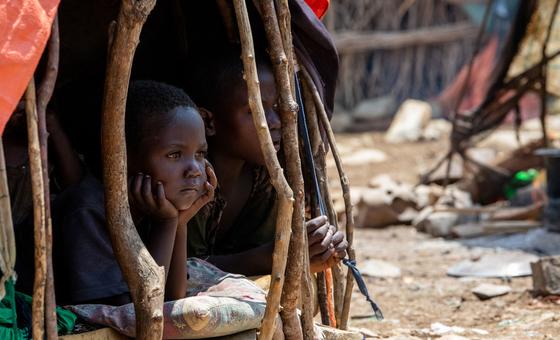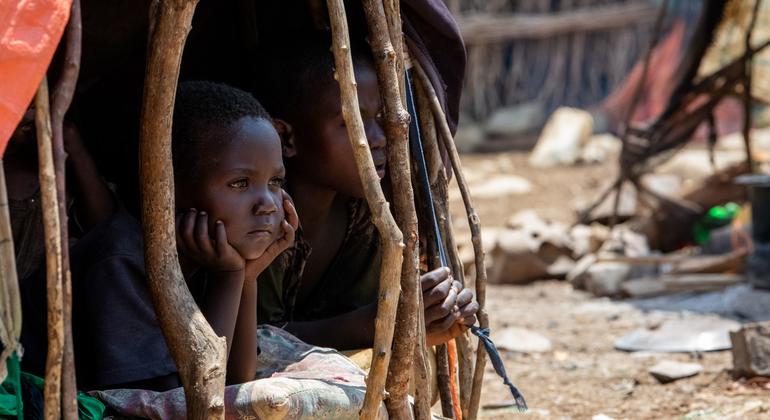
Mr. Guterres’s appeal came as the UN refugee agency, UNHCR, warned about the ongoing crisis faced by people displaced by violence from Somalia to Ethiopia.
Relocation for the most vulnerable has begun, said UNHCR, after an uptick in violence in northern Somalia’s Lascanood city pushed close to 100,000 people to flee to a remote area of Ethiopia’s Somali region in the past two months.
“Since clashes started in mid-February, thousands of people have arrived in the Somali region of Ethiopia seeking safety,” said UNHCR spokesperson Olga Sarrado. “As of last week, 91,000 people had been registered by the Ethiopian authorities.”
Ms. Sarrado added that although the pace of arrivals had slowed, refugees continue to show up, fleeing ongoing violence in Somalia.
Ethiopia currently hosts a total of nearly 990,000 refugees from neighbouring countries including South Sudan, Somalia, Eritrea, and Sudan.
Thousands of unaccompanied children
According to UNHCR, most of the refugees arriving from Somalia are women, children and older people, including “more than 3,400 unaccompanied and separated children and adolescents”.
Ms. Sarrado said that these young refugees had told UNHCR “harrowing stories” of how they became separated from their families when clashes began and have since been unable to re-establish contact with their family members.
Relocating the most vulnerable
Now, a relocation of some of the refugees is underway, “with 1,036 of the most vulnerable people transferred from border areas to a new settlement over the past three days”, Ms. Sarrado said.
Transportation to a new site, located some 50 kilometres from the border in Mirqaan, Bokh district, is being organized by the Ethiopian authorities with UNHCR and partners.
Better protection and services
Ms. Sarrado said that “the Government of Ethiopia has generously allocated 400 hectares where refugees can settle and access existing services, such as health care, water and education”, adding that “UNHCR continues to engage with local authorities and leaders to assess gaps in basic services, so support benefits both refugees and Ethiopians as well”.
With needs on the rise, the establishment of the new site is designed to help provide newly arrived refugees who have been living in precarious conditions with shelter, core relief items, food and water.
Ms. Sarrado explained that “relocation is taking place because [refugees] were settling at the border with Somalia, they were sleeping outdoors, the areas where they were staying started to be overcrowded, leading to increased protection risks”.
A multi-faceted crisis
The fighting in Lascanood, which is the capital of the Sool region and part of the breakaway territory of Somaliland, has opposed Somaliland troops and a local clan claiming the town.
In a joint statement in February this year, the United Nations and an international coalition of partners condemned the violence and expressed concern about attacks against civilians, calling for “unhindered humanitarian access” to the remote area in order to “urgently address the needs of those displaced and impacted by the ongoing violence”.
In March, UNHCR and humanitarian partners launched a $116 million inter-agency emergency refugee response plan to respond to critical needs faced by refugees and host communities in the area.
Just last week, in its latest update on the crisis, the UN Office for the Coordination of Humanitarian Affairs (OCHA) said that the situation has escalated “at a time when people in Sool Region are experiencing unprecedented water shortages due to severe drought and facing an elevated risk of disease outbreaks”.
Both Somalia and neighbouring Ethiopia have been hit hard by a historic five years of drought in the Horn of Africa.
Support for Somalia
Speaking in Mogadishu on Tuesday at a press encounter with the President of Somalia, Hassan Sheikh Mohamud, UN chief Mr. Guterres said that “Somali people deserve the solidarity of the international community”.
He called for urgent funding for the 2023 Humanitarian Response Plan for the country, currently only 15 per cent funded.



